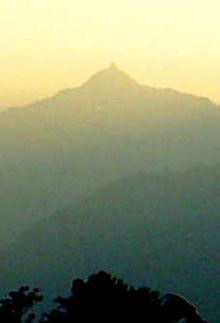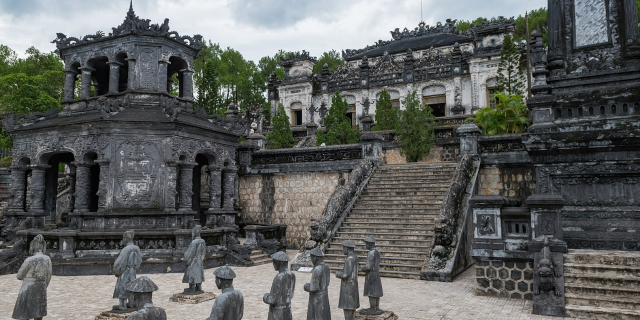Vat Phou (or Vat Phu; Lao: ວັດພູ [wāt pʰúː] temple-mountain) is a ruined Khmer Hindu temple complex in southern Laos and one of the oldest places of worship in Southeast Asia. It is at the base of mount Phou Khao, some 6 kilometres (3.7 mi) from the Mekong in Champasak province.
There was a sanctuary on the site, centred on a sacred spring and an offering place for a mighty tutelary sprit dating back to pre-historic times. The first megalithic stone structures had been built probably as early as the second century BCE, consisting of two stone cells, a carving of a crocodile, serpent stairs, and several offering platforms. One of the first pre-Angkor brick buildings onsite was erected in the early 7th century and became the focus of all consequent building activities. Most of the other surviving buildings date from the Angkor period, in the 11th—13th centuries.
 Northern palace in the Wat Phou complex.
Northern palace in the Wat Phou complex. Phou Khao has a natural lingam on its peak.
Phou Khao has a natural lingam on its peak.Vat Phou was initially associated with the city of Shrestapura,[1]: 66 which lay on the bank of the Mekong directly east of Lingaparvata Mountain (now called Phou Khao).[1] By the latter part of the fifth century, the city was the capital of a kingdom that texts and inscriptions connect with the Chenla Kingdom and Champa. The first structure on the mountain was constructed around this time.[2] The mountain gained spiritual importance from the lingam-shaped protuberance on its summit. The mountain itself was, therefore, considered the home of Shiva, and the river as representing the ocean or the Ganges.[3]
Vat Phou was a part of the Khmer Empire centred on Angkor to the southwest, at least as early as the reign of Yasovarman I in the early 10th century. Shrestapura was superseded by a new city in the Angkorian period, directly south of the temple.[4] In the later period, the original buildings were replaced, re-using some of the stone blocks; the temple now seen was built primarily during the Koh Ker and Baphuon periods of the 11th century. Minor changes were made during the following two centuries, before the temple, like most in the empire, was converted to Theravada Buddhist use.
This continued after the area came under control of the Lao, and a festival is held on the site each February. Little restoration work has been done, other than the restoration of boundary posts along the path. Vat Phou was designated a World Heritage Site in 2001.[2]

































Add new comment